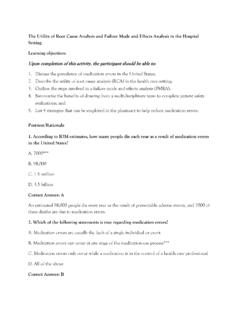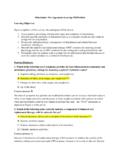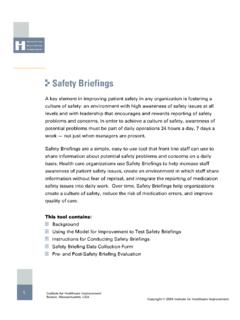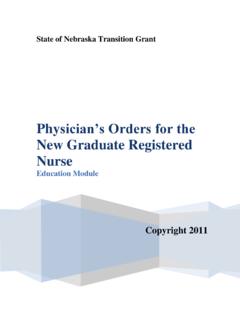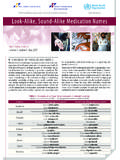Transcription of Medication Safety: The Role of the Technician in ...
1 Medication Safety: The Role of the Technician in preventing Medication errors posttest 1. Which of the following statements is true regarding Medication errors and adverse drug reactions? A. All adverse drug reactions are preventable B. All Medication errors cause patient harm C. All adverse drug reactions are caused by process errors D. All Medication errors are preventable** Correct Answer: D Medication errors are a type of adverse drug event (ADE). ADEs include adverse drug reactions and Medication errors . Medication errors can be viewed as process errors , while adverse reactions are negative clinical outcomes. All adverse drug reactions cause patient harm, but not all adverse drug reactions are preventable.
2 All Medication errors are preventable, but not all Medication errors cause patient harm. 2. According to studies, Medication errors occur most frequently in which of the following patient populations? A. Very young and very old patients** B. Female patients C. Adolescent patients D. Patients enrolled in Medication reconciliation programs Correct Answer: A Medication errors occur more frequently in very young and very old patients and the errors tend to me more serious in these populations. 3. Approximately what percentage of individuals who use medications do so incorrectly or inappropriately? A. 20% B. 30% C. 50%** D. 70% Correct Answer: C It is estimated that one-half of individuals who use medications do so incorrectly or inappropriately.
3 4. Which of the following errors occur during the prescribing step of the Medication -use process? A. Incorrectly preparing the Medication B. Affixing the wrong label to the prescription container C. Duplicating existing drug therapy** D. Improperly storing a Medication Correct Answer: C errors that occur during the prescribing stage of Medication use include irrational, inappropriate, or ineffective choice of Medication based on indication; prescribing a Medication for a patient with a known allergy; duplicating existing drug therapy; choosing an incorrect dose (underprescribing or overprescribing) or dosage form; providing incorrect instructions for use; and writing the prescription with illegible handwriting.
4 5. According to the pharmacy Technician survey mentioned in the activity, technicians indicated that the following factors were the most frequent cause of Medication errors : A. Too many technicians on duty and noise B. Equipment malfunctions and phone calls C. Illegible handwriting and poor lighting D. Interruptions and inadequate staffing** Correct Answer: D Rationale: Pharmacies across all care settings offer numerous opportunities for many types of Medication errors . A survey of pharmacy technicians revealed that interruptions and inadequate staffing were the most frequent causes of Medication errors . Other common sources of error in community pharmacy included handwritten prescriptions, similar packaging or naming conventions, and lack of control in the process of preparing and labeling prescriptions.
5 6. According to the Institute for Safe Medication Practices (ISMP), which of the following medications (or group of medications) is considered high-risk? A. Acetaminophen B. Any combination product C. Homeopathic agents D. Insulin** Correct Answer: D The list of high-alert medications in community settings includes carbamazepine, metformin, warfarin, all antiretroviral agents, all chemotherapeutic agents, insulin, opioids, pediatric medications that require measurement, and medications categorized as pregnancy category X. The entire list, as well as lists of high-alert medications in other settings, is available on the ISMP website. 7. Which of the following prescriptions is written correctly, in terms of abbreviations, symbols, and designations?
6 A. APAP 1000 mg B. Ciprodex 4 gtts AU C. Clonazepam mg twice daily** D. Humalog SSRI per MD instructions Correct Answer: C Unapproved abbreviations include g for micrograms; AD, AS, and AU and OD, OS, and OU for right ear, left ear, and both ears and right eye, left eye, and both eyes, respectively; the abbreviation cc for cubic centimeters; the abbreviation for daily; and the abbreviations SSI and SSRI for sliding scale insulin and sliding scale regular insulin, respectively. Drug names should not be abbreviated or written in shorthand. Trailing zeros should never be used after a decimal point and a zero should always precede a decimal point when the dose is less than a whole unit.
7 When these symbols, abbreviations, or designations appear on prescriptions, pharmacy technicians should bring these to the attention of the pharmacist this will help mitigate the chance of a Medication error. 8. Which of the following is a characteristic of a just culture? A. Employees are encouraged to report errors and analyze why the errors occurred** B. Each error is considered a stand-alone incident C. errors are considered system failures, so no personal accountability is required D. Blame for an error is directly assigned to the person who made the mistake Correct Answer: A A just culture is crucial to successful monitoring and reporting of Medication errors . This blame-free attitude focuses on the system failures that led to an error, rather than the person who made the error.
8 This concept avoids punishment for the error, and, instead, uses the error as an opportunity to learn and improve the system. Negligent or reckless behaviors are still punishable, and, as such, a just culture still requires personal accountability. Employees are encouraged to report and document errors , but, more than that, they are encouraged to understand risk and improve systems to mitigate the risks. 9. Which system would be used to report an ADE related to a cosmetic product? A. HAMMERS B. The Joint Commission C. MedWatch** D. None of the above Correct Answer: C The Food and Drug Administration s MedWatch system is a voluntary surveillance program for adverse events related to marketed drugs and devices.
9 errors reported to MedWatch involve not only prescription and over-the-counter drug products, but also vitamins, nutritional supplements, infant formulas, and cosmetics. 10. What steps can be taken to minimize the selection of the wrong Medication stock bottle from the pharmacy shelf? A. Use the barcode scanner** B. Rewrite the prescription using tall-man lettering C. Obtain a verbal order from the physician s office D. Perform a root cause analysis Correct Answer: A During the filling of a prescription, it is easy to select the wrong stock bottle from a pharmacy shelf since many medications have names and packages that look and sound alike. Many pharmacies have systems in place, such as barcode scanning or National Drug Code verification, to decrease the likelihood of choosing the wrong drug product.
10



